目录
-
涉及到二叉树的构造,无论普通二叉树还是二叉搜索树一定前序,都是先构造中节点。
-
求普通二叉树的属性,一般是后序,一般要通过递归函数的返回值做计算。
-
求二叉搜索树的属性,一定是中序了,要不白瞎了有序性了。
1、二叉树的递归遍历
// 前序遍历·递归·LC144_二叉树的前序遍历
class Solution {
public List<Integer> preorderTraversal(TreeNode root) {
List<Integer> result = new ArrayList<Integer>();
preorder(root, result);
return result;
}
public void preorder(TreeNode root, List<Integer> result) {
if (root == null) {
return;
}
result.add(root.val);
preorder(root.left, result);
preorder(root.right, result);
}
}
// 中序遍历·递归·LC94_二叉树的中序遍历
class Solution {
public List<Integer> inorderTraversal(TreeNode root) {
List<Integer> res = new ArrayList<>();
inorder(root, res);
return res;
}
void inorder(TreeNode root, List<Integer> list) {
if (root == null) {
return;
}
inorder(root.left, list);
list.add(root.val); // 注意这一句
inorder(root.right, list);
}
}
// 后序遍历·递归·LC145_二叉树的后序遍历
class Solution {
public List<Integer> postorderTraversal(TreeNode root) {
List<Integer> res = new ArrayList<>();
postorder(root, res);
return res;
}
void postorder(TreeNode root, List<Integer> list) {
if (root == null) {
return;
}
postorder(root.left, list);
postorder(root.right, list);
list.add(root.val); // 注意这一句
}
}2、二叉树的迭代遍历(非递归)
递归的实现就是:每一次递归调用都会把函数的局部变量、参数值和返回地址等压入调用栈中,然后递归返回的时候,从栈顶弹出上一次递归的各项参数,所以这就是递归为什么可以返回上一层位置的原因。
2.1 前序遍历
前序遍历是根左右,每次先处理的是中间节点,那么先将根节点放入栈中,然后将右孩子加入栈,再加入左孩子。为什么要先加入 右孩子,再加入左孩子呢? 因为这样出栈的时候才是中左右的顺序。
class Solution {
public List<Integer> preorderTraversal(TreeNode root) {
List<Integer> result = new ArrayList<>();
if (root == null){
return result;
}
Stack<TreeNode> stack = new Stack<>();
stack.push(root);
while (!stack.isEmpty()){
TreeNode node = stack.pop();
result.add(node.val);
if (node.right != null){
stack.push(node.right);
}
if (node.left != null){
stack.push(node.left);
}
}
return result;
}
}2.2 中序遍历
中序遍历是左根右,先访问的是二叉树顶部的节点,然后一层一层向下访问,直到到达树左面的最底部,再开始处理节点(也就是在把节点的数值放进result数组中),这就造成了处理顺序和访问顺序是不一致的。那么在使用迭代法写中序遍历,就需要借用指针的遍历来帮助访问节点,栈则用来处理节点上的元素。
class Solution {
public List<Integer> inorderTraversal(TreeNode root) {
List<Integer> result = new ArrayList<>();
if (root == null){
return result;
}
Stack<TreeNode> stack = new Stack<>();
TreeNode cur = root;
while (cur != null || !stack.isEmpty()){
if (cur != null){
stack.push(cur);
cur = cur.left;
}else{
cur = stack.pop();
result.add(cur.val);
cur = cur.right;
}
}
return result;
}
}2.3 后序遍历
后序遍历是左右中,那么我们只需要调整一下先序遍历的代码顺序,就变成中右左的遍历顺序,然后在反转result数组,输出的结果顺序就是左右中了,如下图:

所以后序遍历只需要前序遍历的代码稍作修改就可以了,代码如下:
// 后序遍历顺序 左-右-中 入栈顺序:中-左-右 出栈顺序:中-右-左, 最后翻转结果
class Solution {
public List<Integer> postorderTraversal(TreeNode root) {
List<Integer> result = new ArrayList<>();
if (root == null){
return result;
}
Stack<TreeNode> stack = new Stack<>();
stack.push(root);
while (!stack.isEmpty()){
TreeNode node = stack.pop();
result.add(node.val);
if (node.left != null){
stack.push(node.left);
}
if (node.right != null){
stack.push(node.right);
}
}
Collections.reverse(result);
return result;
}
}3、二叉树的层序遍历
/**
* Definition for a binary tree node.
* public class TreeNode {
* int val;
* TreeNode left;
* TreeNode right;
* TreeNode() {}
* TreeNode(int val) { this.val = val; }
* TreeNode(int val, TreeNode left, TreeNode right) {
* this.val = val;
* this.left = left;
* this.right = right;
* }
* }
*/
class Solution {
List<List<Integer>> resList = new ArrayList<List<Integer>>();
public List<List<Integer>> levelOrder(TreeNode root) {
fun(root,0);
return resList;
}
/**
* 整体逻辑就是:当reslist.size < deep时,那就创建list
* 等于或者大于时,就该往相应的list里面添加元素了。
* @param root
* @param deep
*/
private void fun(TreeNode root,int deep) {
//思路:每一层对应一个list,最后的结果是一个大的list
if (root == null) return ;
deep++; //代表当前在第几层
if (resList.size() < deep){
//当层级增加时,存放每层元素的集合数也增加,即当前在第几层那么reslist里面就有几个list
List<Integer> list = new ArrayList<Integer>();
resList.add(list);
}
resList.get(deep -1).add(root.val);
fun(root.left,deep);
fun(root.right,deep);
}
//队列实现
public List<List<Integer>> levelOrder1(TreeNode root) {
List<List<Integer>> resList = new ArrayList<List<Integer>>();
if(root == null)return resList;
Queue<TreeNode> que = new LinkedList<TreeNode>();
que.offer(root); //队列尾部插入元素
while (!que.isEmpty()){
List<Integer> list = new ArrayList<Integer>();
int len = que.size();
while (len > 0){
TreeNode tmpNode = que.poll();
list.add(tmpNode.val);
if (tmpNode.left !=null)que.offer(tmpNode.left);
if (tmpNode.right != null)que.offer(tmpNode.right);
len--;
}
resList.add(list);
}
return resList;
}
}3.1 二叉树的层序遍历II
给定一个二叉树,返回其节点值自底向上的层次遍历。 (即按从叶子节点所在层到根节点所在的层,逐层从左向右遍历),相对于二叉树的层序遍历,就是最后把result数组反转一下就可以了。
3.2 二叉树的右视图
给定一棵二叉树,想象自己站在它的右侧,按照从顶部到底部的顺序,返回从右侧所能看到的节点值。
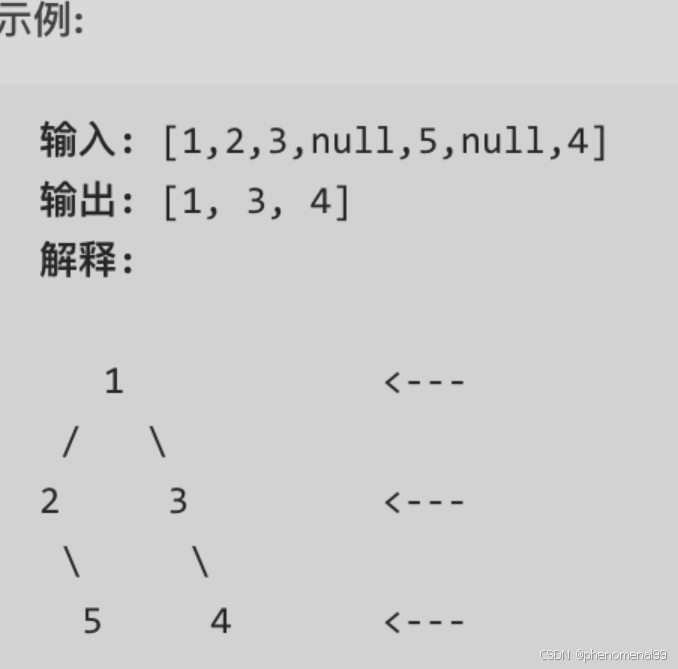
思路:层序遍历,遍历每一层的最后一个节点
public class Case199 {
//递归
public List<Integer> rightSideView(TreeNode root) {
List<Integer> resList = new ArrayList<>();
fun(root,0,resList);
return resList;
}
private void fun(TreeNode root,int deep,List<Integer>resList) {
if (root == null)return;
if (deep == resList.size()){ //这个深度首次达到
resList.add(root.val);
}
fun(root.right,deep + 1,resList);
fun(root.left,deep + 1,resList); //这个妙啊!!
}
//层序遍历,每次返回每层的最后一个节点
public List<Integer> rightSideView1(TreeNode root) {
Queue<TreeNode> que = new LinkedList<>();
List<Integer> list = new ArrayList<>();
if (root == null) return list;
que.offer(root);
while (!que.isEmpty()) {
int len = que.size();
while (len > 0){
TreeNode tmp = que.poll();
if (tmp.left != null) que.offer(tmp.left);
if (tmp.right != null) que.offer(tmp.right);
len--;
if (len == 0)list.add(tmp.val);
}
}
return list;
}
}3.3 二叉树的层平均值
给定一个非空二叉树, 返回一个由每层节点平均值组成的数组。
public class Case637 {
public List<Double> averageOfLevels(TreeNode root) {
List<Double> list = new ArrayList<>();
if (root == null)return list;
Queue<TreeNode> queue = new LinkedList<>();
queue.offer(root);
while (!queue.isEmpty()){
int len = queue.size();
Double sum = 0.0;
while (len > 0){
TreeNode tem = queue.poll();
sum += tem.val;
if (tem.left !=null)queue.offer(tem.left);
if (tem.right != null)queue.offer(tem.right);
len--;
if (len == 0){
Double res = sum / len;
list.add(res);
}
}
}
return list;
}
}3.4 N叉树的层序遍历
给定一个 N 叉树,返回其节点值的层序遍历。 (即从左到右,逐层遍历)。例如,给定一个 3叉树 :
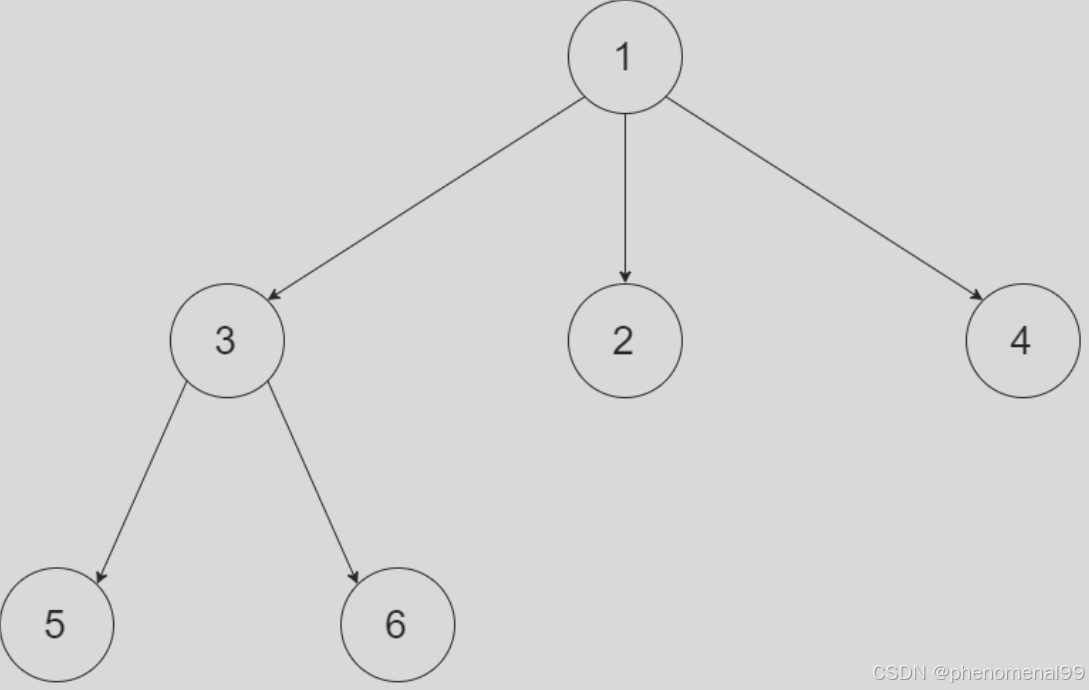
返回其层序遍历:[ [1], [3,2,4], [5,6] ]
/*
// Definition for a Node.
class Node {
public int val;
public List<Node> children;
public Node() {}
public Node(int _val) {
val = _val;
}
public Node(int _val, List<Node> _children) {
val = _val;
children = _children;
}
};
*/
public class Case429 {
public List<List<Integer>> levelOrder(Node root) {
List<List<Integer>> res = new ArrayList<>();
if (root == null ){
return res;
}
Queue<Node> queue = new LinkedList<>();
queue.offer(root);
while (!queue.isEmpty()){
List<Integer> list = new ArrayList<>();
int len = queue.size();
while (len > 0){
Node p = queue.poll();
list.add(p.val);
if (p.children != null){
for (Node child : p.children) {
queue.offer(child);
}
}
len--;
}
res.add(list);
}
return res;
}
}
3.5 在每个树行中找最大值
public class Case515 {
/**
* 给定一棵二叉树的根节点 root ,请找出该二叉树中每一层的最大值。
* @param root
* @return
*/
public List<Integer> largestValues(TreeNode root) {
List<Integer> res = new ArrayList<>();
Queue<TreeNode> queue = new LinkedList<>();
if (root == null) return res;
queue.offer(root);
while (!queue.isEmpty()) {
int len = queue.size();
int max = Integer.MIN_VALUE;
for (int i = 0; i < len; i++) {
TreeNode p = queue.poll();
max = Math.max(p.val, max);
if (p.left != null)queue.offer(p.left);
if (p.right != null)queue.offer(p.right);
}
res.add(max);
}
return res;
}
}
3.6 填充每个节点的下一个右侧节点指针
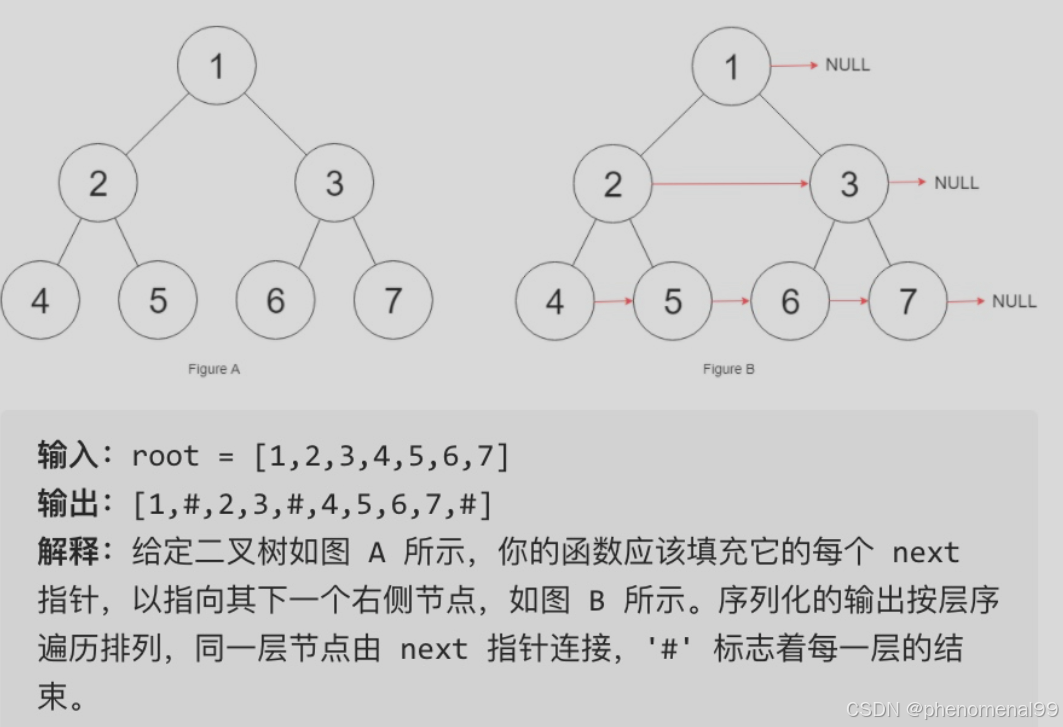
public class Case116 {
public Pnode connect(Pnode root) {
if (root == null) return null;
Queue<Pnode> queue = new LinkedList<Pnode>();
queue.offer(root);
while (!queue.isEmpty()){
int len = queue.size();
while (len > 0){
Pnode tem = queue.poll();
len--;
if (len == 0){
tem.next = null;
}else {
tem.next = queue.peek();
}
if (tem.left != null)queue.offer(tem.left);
if (tem.right != null)queue.offer(tem.right);
}
}
return root;
}
}3.7 填充每个节点的下一个右侧节点指针II
与上题一样
3.8 二叉树的最大深度
给定一个二叉树,找出其最大深度。二叉树的深度为根节点到最远叶子节点的最长路径上的节点数。说明: 叶子节点是指没有子节点的节点。
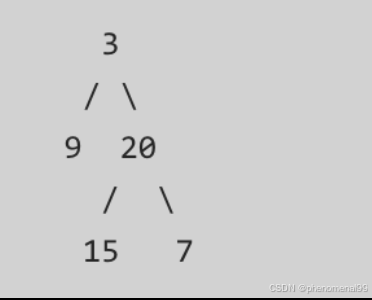
返回它的最大深度 3 。
使用迭代法的话,使用层序遍历是最为合适的,因为最大的深度就是二叉树的层数,和层序遍历的方式极其吻合。在二叉树中,一层一层的来遍历二叉树,记录一下遍历的层数就是二叉树的深度,如图所示:
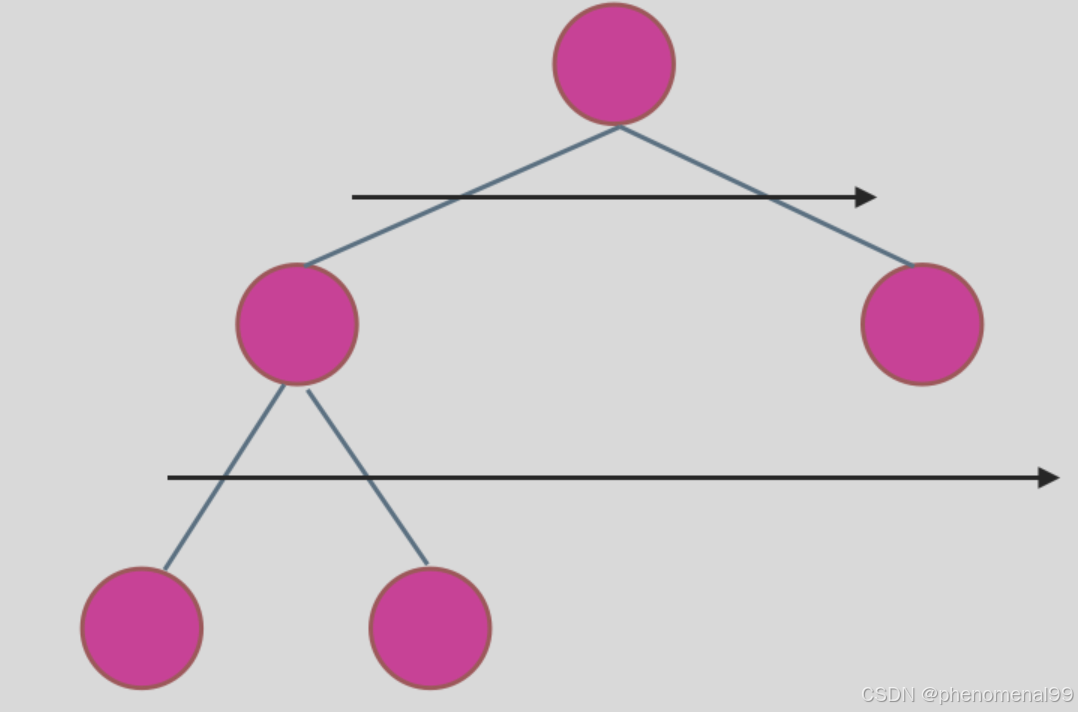
class Solution {
public int maxDepth(TreeNode root) {
if (root == null) return 0;
Queue<TreeNode> que = new LinkedList<>();
que.offer(root);
int depth = 0;
while (!que.isEmpty())
{
int len = que.size();
while (len > 0)
{
TreeNode node = que.poll();
if (node.left != null) que.offer(node.left);
if (node.right != null) que.offer(node.right);
len--;
}
depth++;
}
return depth;
}
//递归
public int maxDepth(TreeNode root) {
if (root == null)return 0;
int lDepth = maxDepth(root.left);
int rDepth = maxDepth(root.right);
int max = Math.max(lDepth,rDepth) + 1;
return max;
}
}3.9 二叉树的最小深度

public class Case111 {
/**
* 与求最大深度还不一样,
* @param root
* @return
*/
public int minDepth(TreeNode root) {
if(root == null) return 0;
int m1 = minDepth(root.left);
int m2 = minDepth(root.right);
//1.如果左孩子和右孩子有为空的情况,直接返回m1+m2+1
//2.如果都不为空,返回较小深度+1
return root.left == null || root.right == null ? m1 + m2 + 1 : Math.min(m1,m2) + 1;
}
// 层序遍历
public int minDepth1(TreeNode root){
if (root == null) return 0;
Queue<TreeNode>queue = new LinkedList<>();
queue.offer(root);
int depth = 0;
while (!queue.isEmpty()){
depth++; //每遍历完一层深度+1
int len = queue.size();
while (len > 0) {
TreeNode p = queue.poll();
if (p.left == null && p.right == null) return depth; //到达叶子节点了
if (p.left != null) queue.offer(p.left);
if (p.right != null) queue.offer(p.right);
len--;
}
}
return depth;
}
}4、反转二叉树
给你一棵二叉树的根节点 root ,翻转这棵二叉树,并返回其根节点。

public class Case226 {
public TreeNode invertTree(TreeNode root) {
if (root == null) return null;
Queue<TreeNode> queue = new LinkedList<>();
queue.offer(root);
while (!queue.isEmpty()){
int len = queue.size();
while (len > 0){
TreeNode p = queue.poll();
swap(p);
if (p.left != null)queue.offer(p.left) ;
if (p.right != null)queue.offer(p.right);
len--;
}
}
return root;
}
private void swap(TreeNode p) {
TreeNode temp = p.left;
p.left = p.right;
p.right = temp;
}
//递归
public TreeNode invertTree1(TreeNode root) {
if (root == null) return null;
invertTree1(root.left);
invertTree1(root.right);
swap(root);
return root;
}
5、对称二叉树
给定一个二叉树,检查它是否是镜像对称的。

/**
* 简单题并不简单
* 按照普通层序遍历法,是行不通的,不应该一个一个出队列
* 而是两个两个出队列
*/
public class Case101 {
public boolean isSymmetric1(TreeNode root) {
Deque<TreeNode> queue = new LinkedList<>();
queue.offerFirst(root.left);
queue.offerLast(root.right);
while (!queue.isEmpty()){
TreeNode a = queue.pollFirst();
TreeNode b = queue.pollLast();
if (a == null && b == null){
continue;
}
if (a == null && b != null)return false;
if (a != null && b == null)return false;
if (a.val != b.val)return false;
queue.offerFirst(a.left);
queue.offerFirst(a.right);
queue.offerLast(b.right);
queue.offerLast(b.left);
}
return true;
}
//递归法
public boolean isSymmetric(TreeNode root) {
return compare(root.left,root.right);
}
private boolean compare(TreeNode left, TreeNode right) {
if (left == null && right != null)return false;
if (left != null && right == null) return false;
if (left == null && right == null)return true;
if (left.val != right.val) return false;
//比较外侧
boolean compareOutside = compare(left.left,right.right);
//比较内测
boolean compareInside = compare(left.right,right.left);
return compareInside && compareOutside;
}
}
6、平衡二叉树
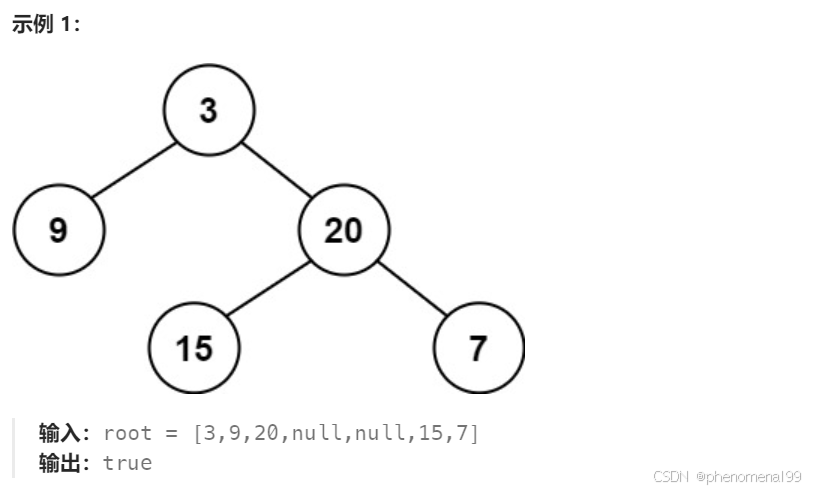
给定一个二叉树,判断它是否是高度平衡的二叉树。一棵高度平衡二叉树定义为:一个二叉树每个节点 的左右两个子树的高度差的绝对值不超过1。
public class Case110 {
public boolean isBalanced1(TreeNode root) {
if (root == null) {
return true;
}
int res = getHeight1(root);
return res == -1 ? false : true;
}
private int getHeight1(TreeNode root) {
if (root == null) return 0;
int m = getHeight1(root.left);
if (m == -1) return -1;
int n = getHeight1(root.right);
if (n == -1) return -1;
if (Math.abs(m - n) > 1) return -1;
return Math.max(m, n) + 1;
}
7、二叉树的所有路径
给定一个二叉树,返回所有从根节点到叶子节点的路径。说明: 叶子节点是指没有子节点的节点。
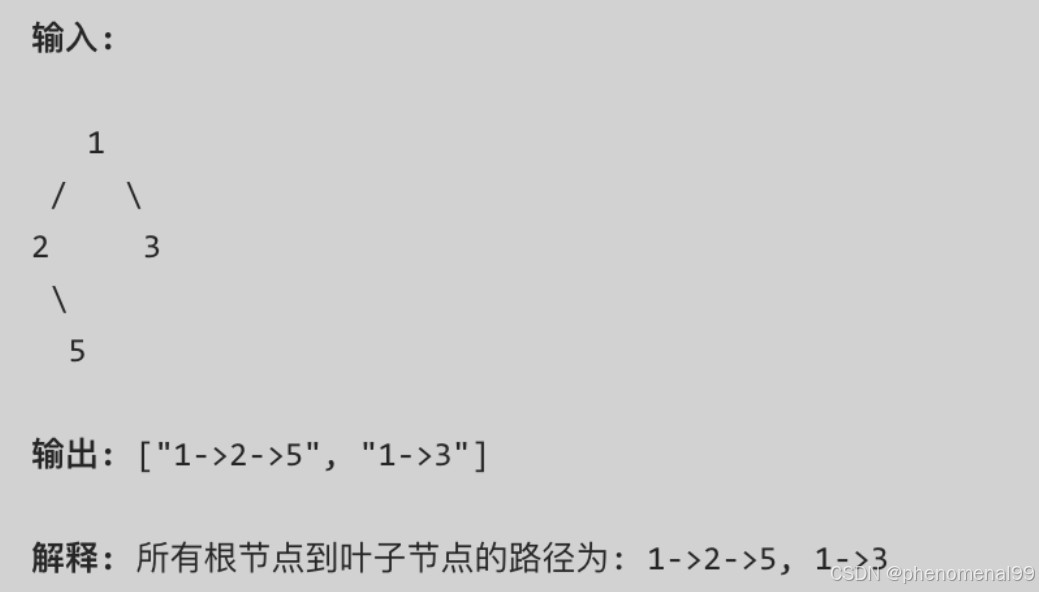
这道题目要求从根节点到叶子的路径,所以需要前序遍历,这样才方便让父节点指向孩子节点,找到对应的路径。在这道题目中将第一次涉及到回溯,因为我们要把路径记录下来,需要回溯来回退一个路径再进入另一个路径。
前序遍历以及回溯的过程如图:

public class Case257 {
public List<String> binaryTreePaths(TreeNode root) {
List<String> res = new ArrayList<>();
if (root == null){
return res;
}
List<Integer> paths = new ArrayList<>(); //作为结果中的路径
traversal(root,paths,res);
return res;
}
//前序遍历
private void traversal(TreeNode root, List<Integer> paths, List<String> res) {
paths.add(root.val);
//遇到叶子节点
if(root.left == null && root.right == null){
StringBuilder sb = new StringBuilder();
for (int i = 0; i < paths.size()-1; i++) {
sb.append(paths.get(i)).append("->");
}
sb.append(paths.get(paths.size() -1)); //记录最后一个节点
res.add(sb.toString()); //收集一个路径
return;
}
// 递归和回溯是同时进行,所以要放在同一个花括号里
if (root.left != null){
traversal(root.left,paths,res);
paths.remove(paths.size() - 1); //回溯
}
if (root.right != null){
traversal(root.right,paths,res);
paths.remove(paths.size() - 1); //回溯
}
}
//迭代法
public List<String> binaryTreePaths1(TreeNode root) {
List<String> result = new ArrayList<>();
if (root == null)return result;
//因为要掉头,所以不用队列要用栈了
Stack<Object> stack = new Stack<>();
//节点和路径同时ru栈
stack.push(root);
stack.push(root.val + "");
while (!stack.isEmpty()){
String path = (String) stack.pop();
TreeNode node = (TreeNode) stack.pop();
//若找到叶子节点
if (node.left == null && node.right == null){
result.add(path);
}
//右子节点不为空
if (node.right != null){
stack.push(node.right);
stack.push(path + "->" + node.right.val);
}
//左节点不为空
if (node.left != null){
stack.push(node.left);
stack.push(path + "->" + node.left.val);
}
}
return result;
}
}
8、左叶子之和
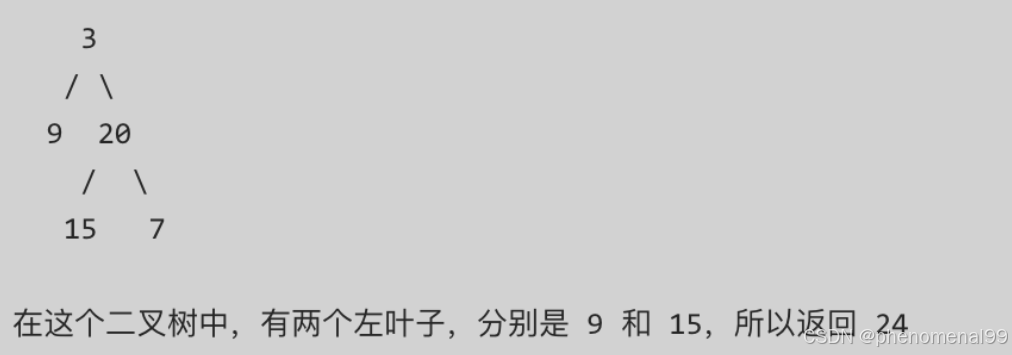
思路:层序遍历,该层的第一个元素且是叶子节点。
public class Case404 {
// 递归(后续遍历)
//如何只让左叶子节点加和?????
public int sumOfLeftLeaves(TreeNode root) {
if (root == null)return 0;
int a = sumOfLeftLeaves(root.left);
int b = sumOfLeftLeaves(root.right);
int midvaule = 0;
if (root.left != null && root.left.left == null && root.left.right == null){
midvaule = root.left.val;
}
int sum = midvaule + a + b;
return sum;
}
//层序遍历
public int sumOfLeftLeaves1(TreeNode root) {
int sum = 0;
if (root == null) return 0;
Queue<TreeNode> queue = new LinkedList<>();
queue.offer(root);
while (queue.isEmpty()){
int len = queue.size();
while (len-- > 0) {
TreeNode node = queue.poll();
if (node.left != null) {
if (node.left.left == null && node.left.right == null) {
sum += node.left.val;
}
}
if (node.right != null) queue.offer(node.right);
}
}
return sum;
}
}9、找树左下角的值
给定一个二叉树,在树的最后一行找到最左边的值。
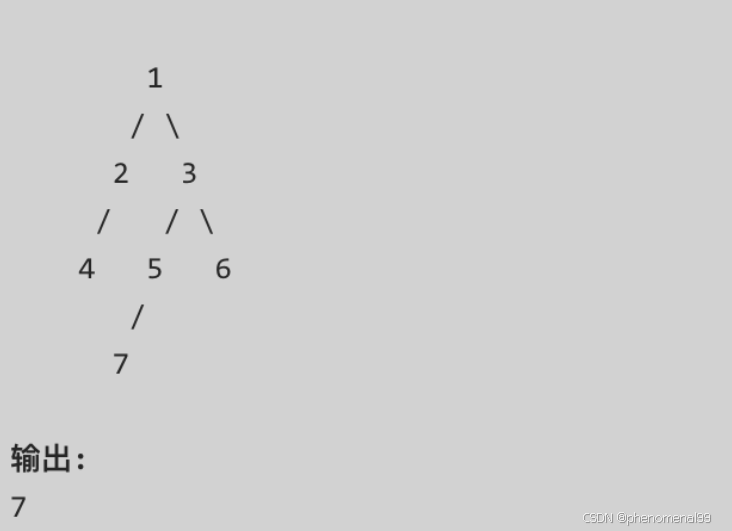
思路: 层序遍历,至最后一行,拿到第一个元素
public class Case513 {
private int DEEP = -1;
private int value = 0;
public int findBottomLeftValue(TreeNode root) {
Queue<TreeNode> queue = new LinkedList<>();
queue.offer(root);
int res = 0;
while (!queue.isEmpty()){
int len = queue.size();
//这样写会导致res的值最后会变成最后一个出队列元素的值,所以这样写循环是不对的
/*while (len-- > 0){
TreeNode p = queue.poll();
res = p.val;
if (p.left != null)queue.offer(p.left);
if (p.right != null)queue.offer(p.right);
}
}*/
for (int i = 0; i < len; i++) {
TreeNode p = queue.poll();
if (i == 0) res = p.val;
if (p.left != null)queue.offer(p.left);
if (p.right != null)queue.offer(p.right);
}
}
return res;
}
/**
* 递归做法:
* 1.确定最大深度,找到最后一层 维护一个全局变量DEEP
* 2.因为是先对左孩子进行递归处理,也即先访问的左孩子。
* 3.维护一个全局变量vaule来记录结果
*/
public int findBottomLeftValue1(TreeNode root) {
value = root.val;
findLeftVaule(root,0);
return value;
}
private void findLeftVaule(TreeNode root, int deep) {
if (root == null)return;
if (root.left == null && root.right == null){
if (deep > DEEP){
value = root.val;
DEEP = deep;
}
}
if (root.left != null)findLeftVaule(root.left,deep + 1);
if (root.right != null)findLeftVaule(root.right,deep + 1);
}
}10、路径总和
给定一个二叉树和一个目标和,判断该树中是否存在根节点到叶子节点的路径,这条路径上所有节点值相加等于目标和。说明: 叶子节点是指没有子节点的节点。示例: 给定如下二叉树,以及目标和 sum = 22
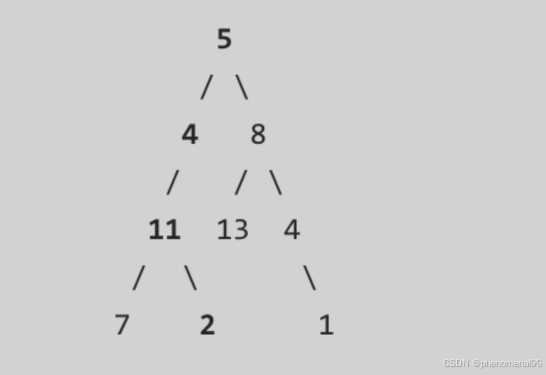
返回 true, 因为存在目标和为 22 的根节点到叶子节点的路径 5->4->11->2。
public class Case112 {
public boolean hasPathSum(TreeNode root, int targetSum) {
if (root == null) return false;
Stack<Object> stack = new Stack<>();
stack.push(root);
stack.push(root.val);
while (!stack.isEmpty()){
int res = (int) stack.pop();
TreeNode node = (TreeNode) stack.pop();
if (node.left == null && node.right == null){
if (res == targetSum)return true;
}
if (node.right !=null){
stack.push(node.right);
stack.push(res + node.right.val);
}
if (node.left !=null){
stack.push(node.left);
stack.push(res + node.left.val);
}
}
return false;
}
}11、构造二叉树
11.1 从中序与后序遍历序列构造二叉树
注意: 你可以假设树中没有重复的元素。
例如,给出
- 中序遍历 inorder = [9,3,15,20,7]
- 后序遍历 postorder = [9,15,7,20,3] 返回如下的二叉树:

public class Case106 {
private static Map<Integer,Integer> map;
public static void main(String[] args) {
int[] inorder = {9,3,15,20,7};
int[] postorder = {9,15,7,20,3};
buildTree(inorder,postorder);
}
public static TreeNode buildTree(int[] inorder, int[] postorder) {
map = new HashMap<>();
for (int i = 0; i < inorder.length; i++) {
map.put(inorder[i],i);
}
return findNode(inorder,0,inorder.length,postorder,0,postorder.length);
}
private static TreeNode findNode(int[] inorder, int inBegin, int inEnd, int[] postorder, int postBegin, int postEnd) {
if (inBegin >= inEnd || postBegin >= postEnd){ //没有元素,返回空树,左闭右开[)
return null;
}
int rootIndex = map.get(postorder[postEnd - 1]); //找到后续遍历的最后一个元素在中序遍历中的位置
TreeNode root = new TreeNode(inorder[rootIndex]); //构造节点
int lenOfLeft = rootIndex - inBegin; //保存中序左子树个数,用来确定后序数列的个数
root.left = findNode(inorder,inBegin,rootIndex,postorder,postBegin,postBegin + lenOfLeft);
root.right = findNode(inorder,rootIndex + 1,inEnd,postorder,postBegin+lenOfLeft,postEnd - 1);
return root;
}
}
11.2 从前序与中序遍历序列构造二叉树
public class Case105 {
Map<Integer,Integer> map = new HashMap<>();
public TreeNode buildTree(int[] preorder, int[] inorder) {
for (int i = 0; i < inorder.length; i++) {
map.put(inorder[i],i);
}
return findNode(inorder,0,inorder.length,preorder,0,preorder.length);
}
private TreeNode findNode(int[] inorder, int inBegin, int inEnd, int[] preorder, int preBegin, int preEnd) {
if (inBegin >= inEnd || preBegin >= preEnd)return null;
int rootIndex = map.get(preorder[preBegin]); //根节点在中序遍历中的索引
TreeNode root = new TreeNode(inorder[rootIndex]);
int lenOfLeft = rootIndex - inBegin;
root.left = findNode(inorder,inBegin,rootIndex,preorder,preBegin + 1,preBegin + lenOfLeft + 1);
root.right = findNode(inorder,rootIndex + 1,inEnd,preorder,preBegin+lenOfLeft + 1,preEnd);
return root;
}
}11.3、最大二叉树
给定一个不含重复元素的整数数组。一个以此数组构建的最大二叉树定义如下:
- 二叉树的根是数组中的最大元素。
- 左子树是通过数组中最大值左边部分构造出的最大二叉树。
- 右子树是通过数组中最大值右边部分构造出的最大二叉树。
通过给定的数组构建最大二叉树,并且输出这个树的根节点。
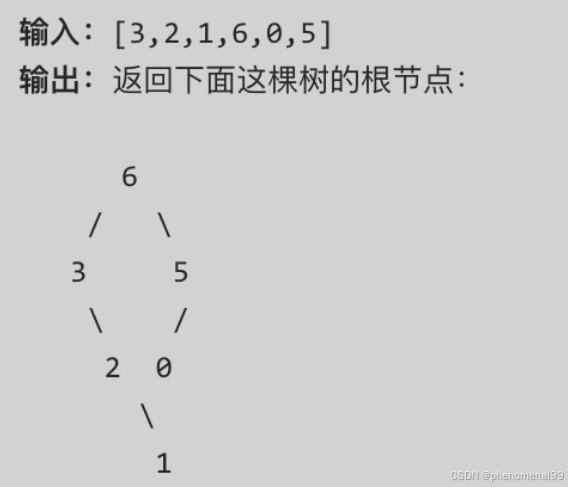
/**
* 给定一个不重复的整数数组 nums 。 最大二叉树 可以用下面的算法从 nums 递归地构建:
* 创建一个根节点,其值为 nums 中的最大值。
* 递归地在最大值左边的子数组前缀上 构建左子树。
* 递归地在最大值右边的子数组后缀上 构建右子树。
* 返回 nums 构建的 最大二叉树
*/
public class Case654 {
public TreeNode constructMaximumBinaryTree(int[] nums) {
if (nums == null)return null;
return findNode(nums,0,nums.length);
}
private TreeNode findNode(int[] nums, int leftIndex, int rightIndex) {
if (leftIndex >= rightIndex){ //数组不合法(左闭右开)
return null;
}
int rootIndex = leftIndex;
int max = nums[rootIndex];
//max = Arrays.stream(nums).max().getAsInt(); //问题出在这,不应该在整个数组中找最大值了
for (int i = leftIndex; i < rightIndex; i++) {
if (nums[i] > max){
max = nums[i];
rootIndex = i;
}
}
TreeNode root = new TreeNode(max);
root.left = findNode(nums,leftIndex,rootIndex);
root.right = findNode(nums,rootIndex + 1,rightIndex);
return root;
}
}
12、合并二叉树
给定两个二叉树,想象当你将它们中的一个覆盖到另一个上时,两个二叉树的一些节点便会重叠。你需要将他们合并为一个新的二叉树。合并的规则是如果两个节点重叠,那么将他们的值相加作为节点合并后的新值,否则不为 NULL 的节点将直接作为新二叉树的节点。

public class Case617 {
public TreeNode mergeTrees(TreeNode root1, TreeNode root2) {
/*if (root1 == null) return root2;
if (root2 == null) return root1;*/
if (root1 == null || root2 == null) {
return root1 == null ? root2:root1;
}
root1.val += root2.val;
root1.left = mergeTrees(root1.left,root2.left);
root1.right = mergeTrees(root1.right,root2.right);
return root1;
}
}13、二叉搜索树
13.1 二叉搜索树中的搜索
给定二叉搜索树(BST)的根节点和一个值。 你需要在BST中找到节点值等于给定值的节点。 返回以该节点为根的子树。 如果节点不存在,则返回 NULL。
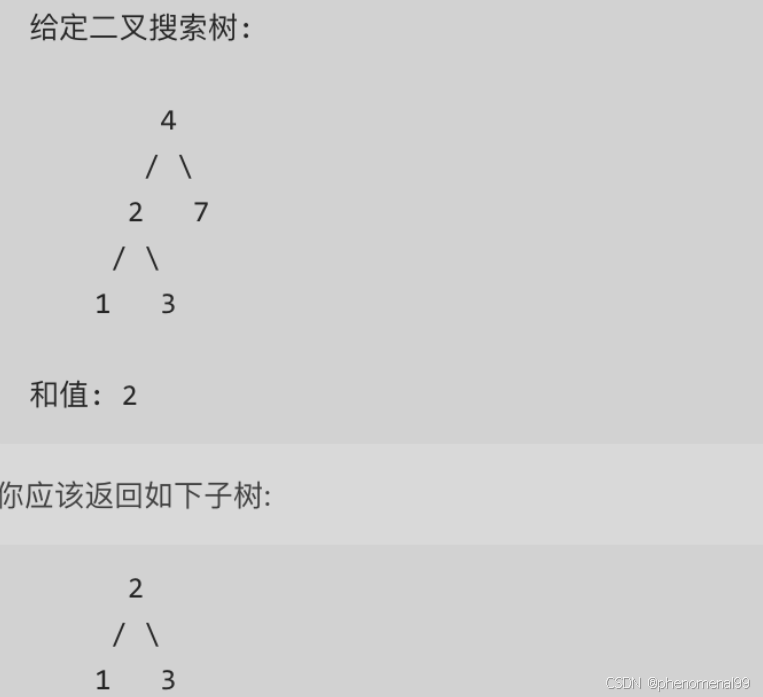
public TreeNode searchBST(TreeNode root, int val) {
/* if (root == null) return null;
if (root.val == val) return root;
TreeNode left = searchBST(root.left,val);
if (left != null){
return left;
}
return searchBST(root.right,val);*/
//利用二叉搜索树的特点
if (root == null || root.val == val) return root;
if (root.val < val){
return searchBST(root.right,val);
}else {
return searchBST(root.left,val);
}
}13.2、验证二叉搜索树
给定一个二叉树,判断其是否是一个有效的二叉搜索树。假设一个二叉搜索树具有如下特征:
- 节点的左子树只包含小于当前节点的数。
- 节点的右子树只包含大于当前节点的数。
- 所有左子树和右子树自身必须也是二叉搜索树。

/**
* 验证二叉搜索树
* 问题所在:不能局部判断,要保证左子树的全部节点都要比root小.......
*/
public class Case98 {
public boolean isValidBST(TreeNode root) {
if (root == null) return true;
/* if (root.left.val >= root.val || root.right.val <= root.val){
return false;
报空指针异常:如果左子树上来为空,那么问题就出现了
}*/
Boolean left = isValidBST(root.left);
Boolean right = isValidBST(root.right);
return left && right;
}
//上述代码问题就出现在全局问题!!!
public boolean isValidBST1(TreeNode root ){
return isValidBSTHelper(root,Long.MIN_VALUE,Long.MAX_VALUE);
}
private boolean isValidBSTHelper(TreeNode root, long minValue, long maxValue) {
if (root == null) return true;
if (root.val <= minValue || root.val >= maxValue){
return false;
}
//确定范围:左孩子一定要比根节点的值小,右孩子一定要比根节点的值要大
return isValidBSTHelper(root.left,minValue, root.val) &&
isValidBSTHelper(root.right, root.val, maxValue);
}
//迭代法
public boolean isValidBST2(TreeNode root ){
if (root == null) return true;
Stack<TreeNode> stack = new Stack<>();
TreeNode pre = null; //记录父节点
while (root != null || !stack.isEmpty()){
while (root != null){
stack.push(root);
root = root.left;
}
TreeNode pop = stack.pop();
if (pre!=null && pop.val <= pre.val){
return false;
}
pre = pop;
root = root.right;
}
return true;
}
}
13.3、二叉搜索树的最小绝对差
给你一棵所有节点为非负值的二叉搜索树,请你计算树中任意两节点的差的绝对值的最小值。

public class Case530 {
int res = Integer.MAX_VALUE;
TreeNode pre; //记录上一个遍历的节点
public int getMinimumDifference(TreeNode root) {
func(root);
return res;
}
private void func(TreeNode root) {
if (root == null) return;
func(root.left);
if (pre != null) {
res = Math.min(res, root.val - pre.val);
}
pre = root;
func(root.right);
}
//迭代法-中序遍历
public int getMinimumDifference1(TreeNode root) {
if (root == null) return 0;
TreeNode pre = null;
Stack<TreeNode> stack = new Stack<>();
TreeNode cur = root;
int res = Integer.MAX_VALUE;
while (cur != null || !stack.isEmpty()) {
if (cur != null) {
stack.push(cur); //将要访问的节点放进栈
cur = cur.left;
} else {
cur = stack.pop();
if (pre != null) { //中
res = Math.min(res, cur.val - pre.val);
}
pre = cur;
cur = cur.right; //右
}
}
return res;
}
}
13.4 二叉搜索树中的众数
给定一个有相同值的二叉搜索树(BST),找出 BST 中的所有众数(出现频率最高的元素)。结果集合中可以是多个元素。
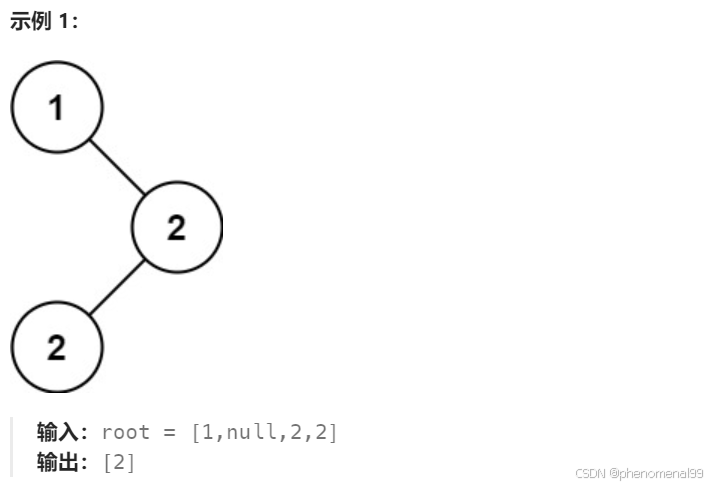
思路:定义全局变量 count 记录节点值出现的次数,maxCount记录出现次数最多的节点值,
public class Case501 {
//迭代遍历
public int[] findMode(TreeNode root) {
if(root == null)return null;
List<Integer> res = new ArrayList<>();
int maxCount = 0;
int count = 0;
TreeNode pre = null;
Stack<TreeNode> stack = new Stack<>();
TreeNode cur = root;
while (cur != null || !stack.isEmpty()){
if (cur != null){
stack.push(cur);
cur = cur.left;
}else {
cur = stack.pop();
if (pre == null || pre.val != cur.val){
count = 1;
}else {
count ++;
}
//更新结果
if (count > maxCount){
maxCount = count;
res.clear(); //重新清空集合
res.add(cur.val);
}else if (count == maxCount){
res.add(cur.val);
}
pre = cur;
cur = cur.right;
}
}
int[] a = new int[res.size()];
for (int i = 0; i < res.size(); i++) {
a[i] = res.get(i);
}
return a;
//return res.stream().mapToInt(Integer:: intValue).toArray();
}
}
13.5 二叉树的最近公共祖先

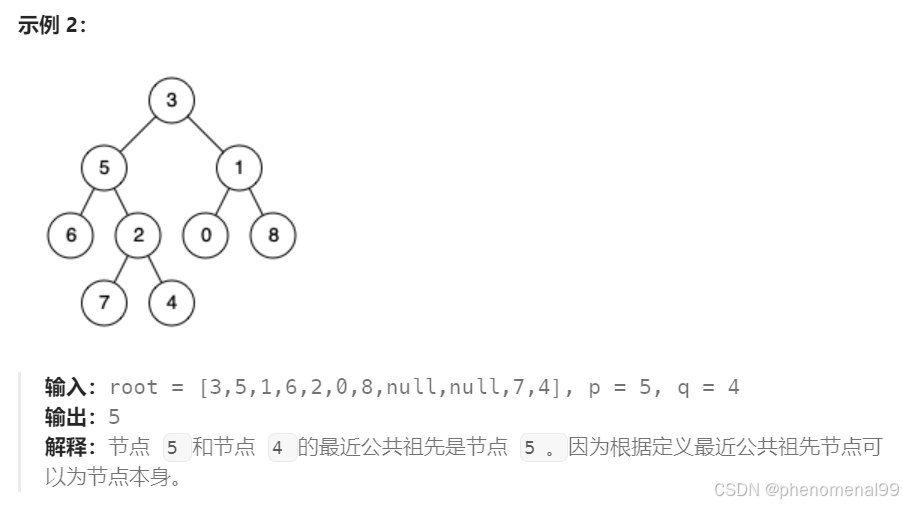

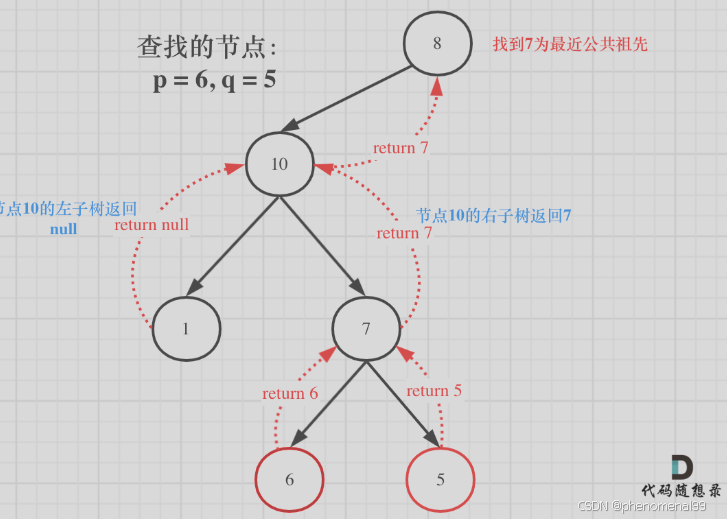
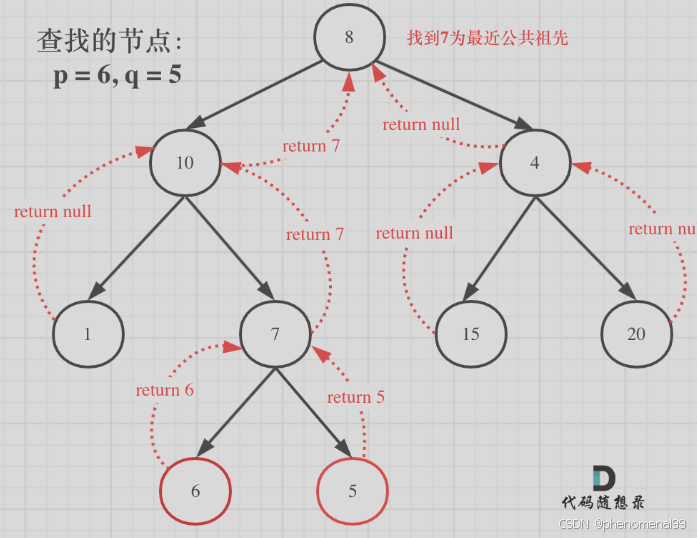
public class Case236 {
/**
* 1.求最小公共祖先,需要从底向上遍历,二叉树,只能通过后序遍历,实现从底向上的遍历方式
* 2.在回溯过程中,必然要遍历整颗二叉树,即使已经找到结果了,依然要把其他节点遍历完,因为要使用递归函数的
* 返回值
* 3.要理解如果返回值为空,right不为空为什么要返回right,为什么可以用返回right传给上一层结果。
* 可以说这里每一步,都是有难度的,都需要对二叉树,递归和回溯有一定的理解。
*本题没有给出迭代法,因为迭代法不适合模拟回溯的过程。理解递归的解法就够了。
*/
//写得太牛逼了!!!! 值得反复揣摩。优雅
public TreeNode lowestCommonAncestor(TreeNode root, TreeNode p, TreeNode q) {
if (root == null || root == p || root == q){ //强啊
return root;
}
//后序遍历
TreeNode left = lowestCommonAncestor(root.left,p,q);
TreeNode right = lowestCommonAncestor(root.right,p,q);
if (left == null && right == null){ //如果未找到节点p或q
return null;
}else if (left == null && right != null){ //若找到一个节点
return right;
}else if (left != null && right == null){
return left;
}else { // 若找到两个节点
return root;
}
}
}
13.6 二叉搜索树的最近公共祖先
public class Case235 {
public TreeNode lowestCommonAncestor(TreeNode root, TreeNode p, TreeNode q) {
if(root == null) return null;
// 如果一个节点比root大,一个比root小,那就最近祖先就是root了啊
while (root != null){
if (root.val > p.val && root.val > q.val){
root = root.left;
}else if (root.val < p.val && root.val < q.val){
root = root.right;
}else {
break;
}
}
return root;
}
//递归
public TreeNode lowestCommonAncestor1(TreeNode root, TreeNode p, TreeNode q) {
if (root.val > p.val && root.val > q.val){
return lowestCommonAncestor(root.left,p,q);
}
if (root.val < p.val && root.val < q.val){
return lowestCommonAncestor(root.right,p,q);
}
return root;
}
}13.7 二叉搜索树中的插入操作
给定二叉搜索树(BST)的根节点和要插入树中的值,将值插入二叉搜索树。 返回插入后二叉搜索树的根节点。 输入数据保证,新值和原始二叉搜索树中的任意节点值都不同。注意,可能存在多种有效的插入方式,只要树在插入后仍保持为二叉搜索树即可。 你可以返回任意有效的结果。
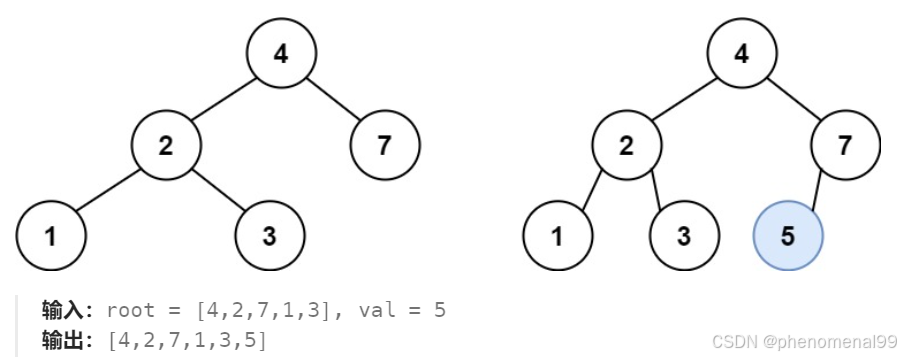
public class Case701 {
public TreeNode insertIntoBST(TreeNode root, int val) {
if (root == null){
TreeNode p = new TreeNode(val);
return p;
}
if (root.val > val){
root.left = insertIntoBST(root.left,val);
}else {
root.right = insertIntoBST(root.right,val);
}
return root;
}
//非递归
public TreeNode insertIntoBST1(TreeNode root, int val) {
if (root == null) return new TreeNode(val);
TreeNode newRoot = root;
TreeNode pre = root;
while (root != null){
pre = root;
if (root.val > val){
root = root.left;
}else if (root.val < val){
root = root.right;
}
}
if (pre.val > val){
pre.left = new TreeNode(val);
}else {
pre.right = new TreeNode(val);
}
return newRoot;
}
}
13.8 删除二叉搜索树中的节点
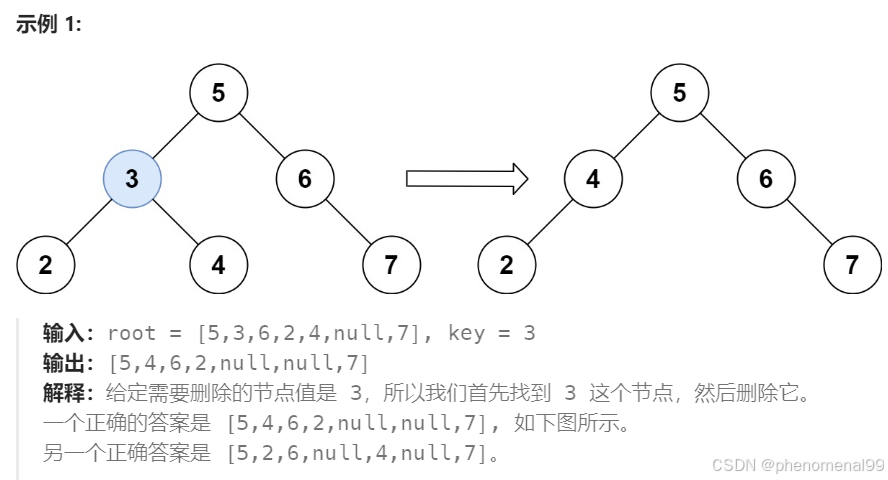
class Solution {
public TreeNode deleteNode(TreeNode root, int key) {
if (root == null) return root;
if (root.val == key) {
if (root.left == null) {
return root.right;
} else if (root.right == null) {
return root.left;
} else {
TreeNode cur = root.right;
while (cur.left != null) {
cur = cur.left;
}
cur.left = root.left;
root = root.right;
return root;
}
}
if (root.val > key) root.left = deleteNode(root.left, key);
if (root.val < key) root.right = deleteNode(root.right, key);
return root;
}
}13.9 修剪二叉搜索树
给定一个二叉搜索树,同时给定最小边界L 和最大边界 R。通过修剪二叉搜索树,使得所有节点的值在[L, R]中 (R>=L) 。你可能需要改变树的根节点,所以结果应当返回修剪好的二叉搜索树的新的根节点。
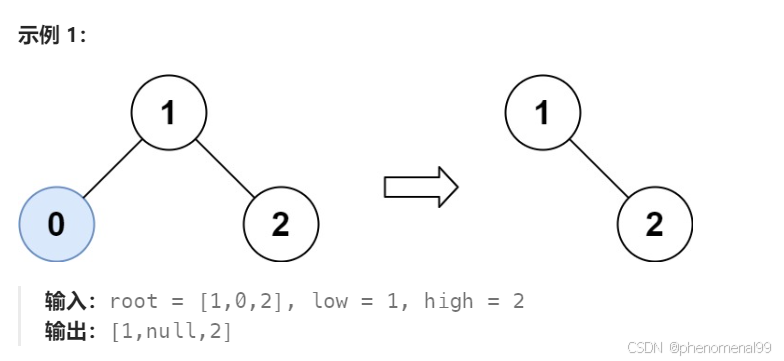
public class Case669 {
public TreeNode trimBST(TreeNode root, int low, int high) {
if(root == null || low > high) return root;
//如果根节点就不在合法范围内,那就先找到第一个合法的节点
while (root != null && (root.val < low || root.val > high)){
if (root.val < low){
root = root.right;
}else {
root = root.left;
}
}
TreeNode curr = root;
//处理左子树
while (curr != null){
while (curr.left != null && curr.left.val < low){
curr.left = curr.left.right;
}
curr = curr.left;
}
curr = root; //重新回到根节点
//处理右子树
while (curr != null){
while (curr.right != null && curr.right.val > high){
curr.right = curr.right.left;
}
curr = curr.right;
}
return root;
}
//递归
public TreeNode trimBST1(TreeNode root, int low, int high) {
/*if (root == null || root.val < low || root.val > high) return null;
root.left = trimBST(root.left, low, high);
root.right = trimBST(root.right, low, high);
return root;*/
if (root == null){
return null;
}
if (root.val < low){
return trimBST1(root.right,low,high);
}
if (root.val > high){
TreeNode a = trimBST1(root.left,low,high);
return a;
}
//root 在合法的范围内
root.left = trimBST1(root.left,low,high);
root.right = trimBST1(root.right,low,high);
return root;
}
}
13.10 将有序数组转换为二叉搜索树
将一个按照升序排列的有序数组,转换为一棵高度平衡二叉搜索树。本题中,一个高度平衡二叉树是指一个二叉树每个节点 的左右两个子树的高度差的绝对值不超过 1。
public TreeNode sortedArrayToBST(int[] nums) {
if (nums == null) return null;
return sortedArrayToBST(nums,0,nums.length);
}
private TreeNode sortedArrayToBST(int[] nums, int left, int right) {
if (left >= right){ //要求左闭右开
return null;
}
int mid = (left + right) / 2;
TreeNode root = new TreeNode(nums[mid]);
root.left = sortedArrayToBST(nums,left,mid);
root.right = sortedArrayToBST(nums,mid + 1,right);
return root;
}
}13.11 把二叉搜索树转换为累加树
给出二叉 搜索 树的根节点,该树的节点值各不相同,请你将其转换为累加树(Greater Sum Tree),使每个节点 node 的新值等于原树中大于或等于 node.val 的值之和。提醒一下,二叉搜索树满足下列约束条件:节点的左子树仅包含键 小于 节点键的节点。 节点的右子树仅包含键 大于 节点键的节点。 左右子树也必须是二叉搜索树。
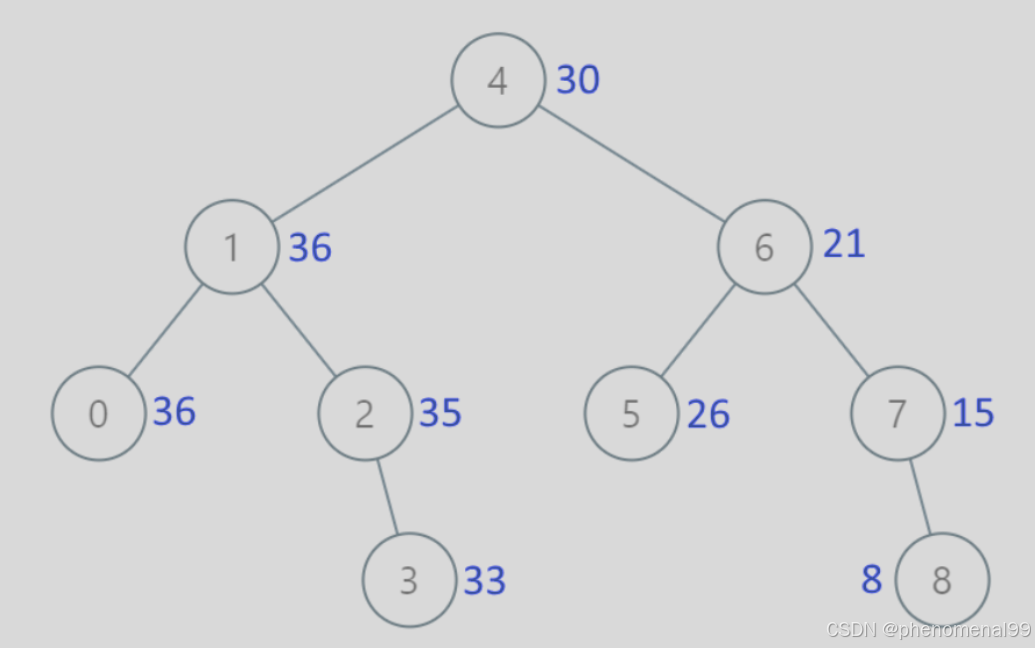
public class Case538 {
private int num = 0;
public TreeNode convertBST(TreeNode root) {
if (root == null)return null;
/*root.right = convertBST(root.right);
if (root.right != null){
root.val = root.val + root.right.val;
}
root.left = convertBST(root.left);
if (root.left != null){
root.left.val = root.val + root.left.val;
}
return root;*/
//上述代码虽然遵从了逆中序遍历,但是由于递归,
convertBST(root.right);
root.val = root.val + num;
num = root.val;
convertBST(root.left);
return root;
}
}























 2660
2660

 被折叠的 条评论
为什么被折叠?
被折叠的 条评论
为什么被折叠?








